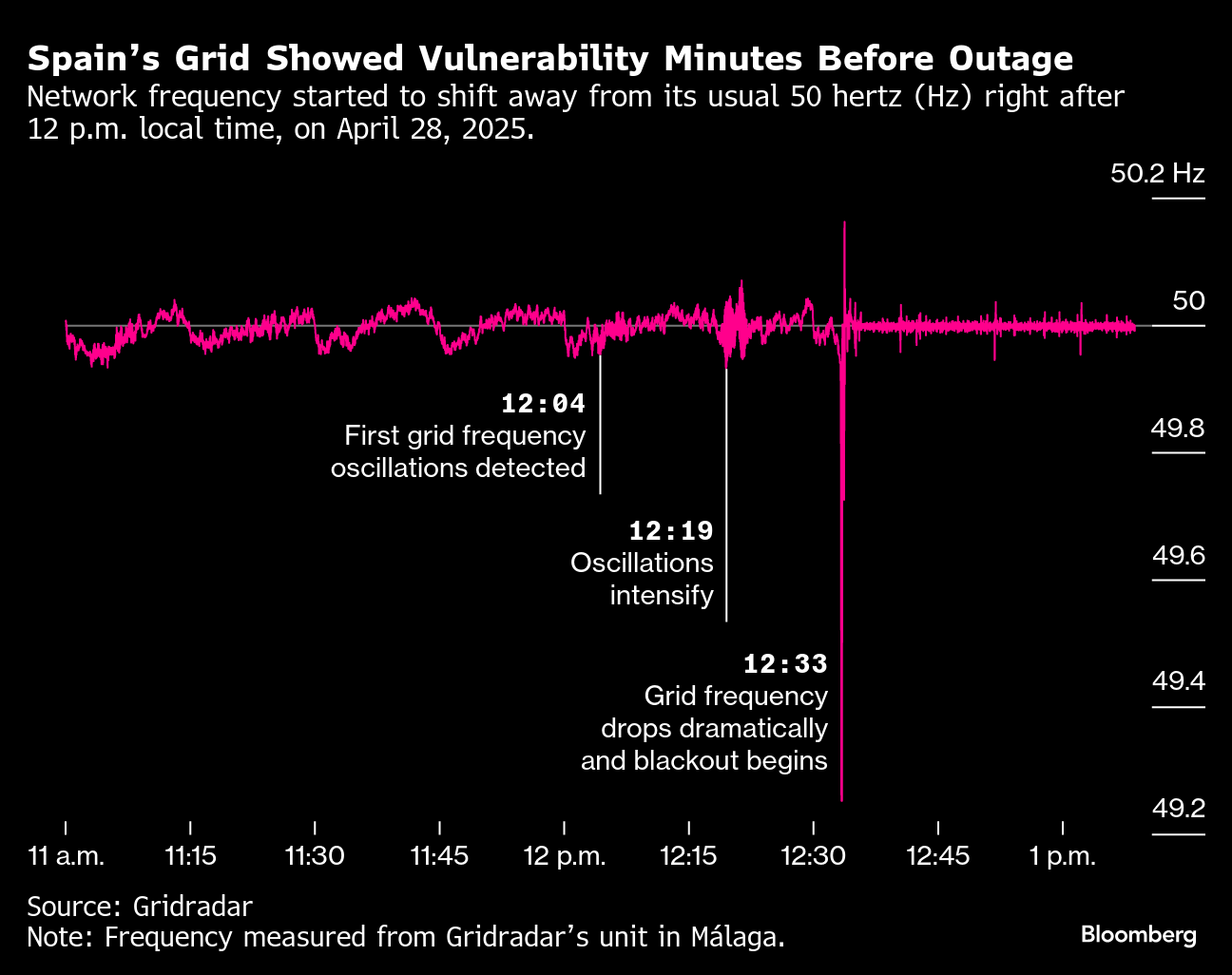Explained: can smarter grids prevent the next blackout of the green energy era?
May 12, 2025
The biggest blackout in Europe’s recent history that unfolded across Spain and Portugal late last month have reignited calls to step up investments in resilient electricity systems – especially in grid upgrades and power storage – as the energy industry navigates the aftermath of the first major power outage of the energy transition era.
But can smarter grids and the management of renewables generation help prevent the next big blackout amidst the rapid growth of wind and solar power, or will factors such as the loss of inertia in electricity systems as they pivot away from coal and gas remain hard to surmount? This has emerged as a key question even as countries and companies embrace renewable energy in an effort to lower their carbon footprint and aim for a net-zero emissions future.
What happened during the blackouts?
While the root cause of the blackout remains unknown, Spain lost around 60% of its power generation, and according to Spanish grid operator Red Electrica the Iberian Peninsula generation crashed to zero at the worst point of the blackout. It took 23 hours until its grid was declared back to normal capacity.
The initial “event” is thought to have originated in south-western Spain, home to the country’s most powerful nuclear power plant, some of its largest hydroelectric dams and several solar farms.
What exactly caused the blackouts?
On the afternoon of the blackout, Spanish Prime Minister Pedro Sánchez told media that the government did not have “conclusive information” on its cause. While the blackout “events” played out in a span of less than 10 seconds, it might be months before the root cause of the catastrophic failure are fully known. While Red Electrica’s initial reporting on the cause has been sparse, EU Energy Commissioner Dan Jørgensen told the BBC that the EU will open a “thorough investigation” into the reasons behind the power cuts.

Although some analysts and experts have cited the underlying role of renewables, Eamonn Lannoye, Managing Director at the Electric Power Research Institute (EPRI) Europe, told the Associated Press that there’s always a variety of things “that usually happen at the same time and it’s very difficult for any event to say ‘this was the root cause’.”
Did renewables play a part in the collapse of the grid?
Although many details remain unknown, several explanations have focused on the role that renewable energy could have played in the blackouts. Those claims follow the context of Europe’s aggressive pursuit of renewables across its energy systems: Spain, for instance, is targeting 81% renewable power by 2030 and 100% by 2050. At the time of the blackout, solar energy accounted for 59% of Spain’s electricity supplies, wind nearly 12%, nuclear 11% and gas around 5%.
In addition, Red Electrica’s head of system operation services Eduardo Prieta was quoted by the Spanish media as saying that it was “very possible that the affected generation [in the initial ‘events’] could be solar”.
However, Spain’s Environment Minister Sara Aagesen has countered those claims and said: “The system has worked to perfection with a similar demand situation and with a similar energetic mix [in the past], so pointing the finger at renewables when the system has functioned perfectly in the same context doesn’t seem very appropriate.”
Why is inertia making the headlines when discussing the blackout?
Massive rotating generators in traditional power plants that run on coal and natural gas have the tendency to keep spinning briefly for a few seconds even without a power source, thereby generating valuable energy particularly when a large plant fails. This “inertia” allows the mechanical systems that control most power plants time to temporarily stabilise the grid and make up for the power lost from the failed generator.
While inertia was taken for granted in operating power plants that run on conventional fossil, nuclear, and hydropower generators, inverter-based resources such as solar photovoltaics, wind, and battery storage follow the grid frequency without the provision of any inertia.
However, in this case, analysts such as Adam Bell, Director of Policy at Stonehaven, have pointed to the fact that the loss of inertia couldn’t have been the main trigger for the blackouts in Spain, as it ignores the inertia provided by nuclear, hydro and thermal on the grid at the time of the event. In addition, the Spanish grid operator said it has built “synchronous condensers” to help boost inertia and grid stability in the system, and after the event itself no hydrocarbon generation remained online, although wind, solar and hydro did.
What does this mean for scaling up investments in smart grids?
The blackouts in Spain come at a critical time for the energy transition with uneven and fragmented adoption of renewables and emerging technologies struggling to scale up. With electricity demand set to grow dramatically due to global economic development and the growth of AI-driven data centres, the urgency of investing in smart and resilient electricity infrastructure is therefore more critical than ever.
“We need to invest urgently in grid resilience, smart infrastructure and energy storage… With the right tools and market design, they can help keep the lights on,” said WindEurope’s CEO Giles Dickson. EU Energy Commissioner Jørgensen echoed that call in the aftermath of blackout: “Energy security should remain our priority. Connectivity, solidarity and clean homegrown energy are key to keeping our energy system more resilient.”
An increasingly complex grid demands more innovative resources that can respond to sudden fluctuations. A toolkit for scaling up smart grids and reducing risks to stability in electricity systems include the following:
- Condensers and stabilisers: Power system stabilisers, synthetic inertia and grid-forming inverters are essential, and grid operators are also turning to battery storage and synchronous condensers.
- Critical role of batteries: An increasingly renewable grid requires different types of energy storage such as batteries, which rapidly correct any frequency issues. Large storage solutions are particularly useful as they don’t need any time to warm up, unlike a gas plant.
- Balanced energy mix: Alongside traditional sources, wind can also play a leading role. Modern turbines can support frequency and voltage, and in some cases, provide synthetic inertia using the kinetic energy in their blades, according to WindEurope, and hybrid projects that combine wind, solar and storage offer even more flexibility and resilience.
- Evolved market regulations: By encouraging large-scale energy storage and co-located renewable projects where wind and/or solar and/or storage operate together, policymakers can help expand and digitalise the grid for a secure and affordable energy future.
Search
RECENT PRESS RELEASES
Related Post




